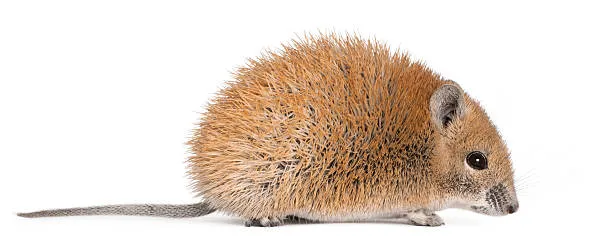Spiny Mice
Spiny mice, or more specifically Acomys, are a unique type of rodent that is not so famous, but they are also considered to be exotic pets of recent fame. These are small, moving animals with certain appearances they have spiky fur on their backs and an interesting temper that always impresses the owners of pets. Spiny mice are indigenous to regions of Africa and the Middle East, and therefore spiny mice are comparatively robust and do not require complex attention for those who want to find an unusual type of animal to have at home.
I will focus on the peculiarities of the diet, average life expectancy, natural environment, and how the spiny mice should be taken care of. Even if one is still planning on getting one or probably already owns one as a pet, one should be able to have a clue about these little creatures and what they need to create that happy and healthy life.
What are spiny mice?
Spiny mice are small rodents of the Acomys genus, of which there are several species. Unlike the house mice, these spiny mice have spiny fur on their back, hence the name spiny. This characteristic, combined with their playfulness and high level of motor activity, makes them quite different from many other small pets.
There are several species of spiny mice, and the type most often bred in captivity is the Egyptian spiny mouse (Acomys cahirinus). They stand about 4 to 5 inches in size, excluding their tail, and they usually live up to 3 to 5 years. It is relatively easy to maintain when compared to many other exotic rodents and are docile and very active.
Spiny mice Lifespan: How Long Do They Live?
The life expectancy of spiny mice varies from 3 up to 5 years depending on the way they are kept or handled. Compared to other pets, this is a small lifespan, but to enhance the lifespan of this small animal, you have to ensure that you offer the creature a proper environment, a proper diet, as well as other required care.
Spiny mice can be affected by their diet, exercise, genetics, and environmental enrichment, as well as whether or not they are kept clean. Like every small pet, these are also stressed with stress that can harm their health and life span. Thus, nurturing environments are critical, and the key to success is in offering strategic environments free from severe hazards.

Why We Eat and What We Eat for Spiny Mice
Nutrition is a very important factor for the survival of your spiny mouse, as is with any other animals on earth. These rodents are herbivores as they feed on both plant- and animal-related products. Good nutrition is important to help reduce the chances of them getting sick, being lethargic, or growing unhappy.
Commercial Rodent Food
Specifically, the feed prepared as the high-quality pellet mix intended for small rodents like gerbils or mice should be considered the base of the spiny mouse’s diet. Choose foods containing seeds, grains, and pellets all in one formula. These are designed to contain the vitamin, mineral, and nutrient requirements for your spiny mouse in the right proportion.
Fresh fruits and vegetables
Besides commercial rodent food, you can feed your spiny mouse with fresh fruits and vegetables in addition. The small pieces of foods like carrots, apples, pears, broccoli, and so on should also be made a part of their diet. But again, there are foods that should never be eaten by mice, such as oranges and other citrus fruits, and onions are poisonous to mice.
Protein Sources
Spiny mice also contain limited quantities of protein but do not need to be limited. These make good extra treats occasionally; you can give your guinea pig mealworms, crickets, or a little bit of cooked chicken. Protein is involved in development, energy, and well-being, vital to young or expecting non-elderly females.
Fresh Water
Fresh water should always be available to your spiny mouse. For this reason, you should get a water bottle with a sippy cup so that your pet can always access clean water. Further, to prevent reaching a situation when the water is dirty, or in the worst-case scenario, it is absent at all, it is necessary to monitor it daily.
Land requirements as well as shelter demands for spiny mice
A cohesive environment is a fundamental requirement that determines your spiny mouse’s comfort and wellness. These mice are quite active and playful, and they need enough space and proper stimulation to provide for them.
Cage Setup
A 10- to 20-gallon tank or a wire cage with a secure bottom is perfectly appropriate for a spiny mouse. This cage should not be too broad but should actually be vertically extended in order that your mouse can much on. Just note that as spiny mice escape artists, they need to be contained in a cage that has a tight-fitting lid. Select a cage with bars on the doors that have about half an inch of space between each bar to avoid funny escapes.
Bedding and Substrate
Spiny mice, the burrowing type, should be provided with deep bedding since they like burrowing. Provide safe soft substrates. We recommend paper-based bedding, aspen wood shavings, or hay that has been proven to be pet-safe. For bedding, do not use cedar or pine shavings, as the oils make it hard to breathe. A daily change of bed linen would help keep the environment free from pollution and infection.
Enrichment and Toys
spiny mice, as they love being very busy and happy to have many things to focus on to play with. In addition to giving them tunnels, hard rubber toys, and small wood or plastic platforms, they will do much to challenge their minds and bodies. You should also put in cardboard boxes or small hideouts made of plastic in the cage, so they retire and take a rest.
Temperature and Humidity
Spiny mice are relatively easy-care animals, and they are comfortable at an average room temperature of around 65°F–75°F (18°C–24°C). They are comfortable with a moderate level of humidity and therefore should not be placed in areas that are draughty or very humid. Placing the cage in a low-light area and avoiding loud noises will also deter stress and attach a sense of safety to the pet.
Caring for Your Spiny Mouse: Health and Maintenance
Spiny mice are generally easy to care for, but they still need proper care so that they stay healthy and are always on the right side.
Cleaning the Cage
It is important to integrate cleanness preservation models in order to avoid the accumulation of waste and promote sanitary status. If possible, they have to clean the cage on a daily basis; otherwise, scrub it at least 3 times a week and always remove the soiled bedding and food. Weekly, replace the contents of the cage, all the bedding, and wash it with soap and water or a pet-friendly disinfectant. Be sure also to take off any meals that might go bad on the premises.
Handling and socializing
Spiny mice are not as manoeuvrable as other animals, such as hamsters, for example, but if desired, they can be tamed in a gradual process. It is a small bird, and often, when picked, they will flutter around. Still, they respond positively to gentle contacts, and if you are willing to spend some time with your spiny mouse, it will start to trust you. They need to be gradually tame, like offering them food in your hand, and then progress to the ability to hold them for a short time.

Health Considerations
Spiny mice are usually in good health, but like many other rodents, they are prone to diseases such as respiratory diseases, skin parasites, and gastrointestinal illness. If you find signs of ill health in your small animal, such as fatigue, loss of appetite, laboured breathing, or nasal or ocular discharge, a veterinarian should be contacted.
Final words
Thus, spiny mice are very interesting and practically do not require any attention, which makes them great for being tamed by those individuals who want to have a small and special rodent as a pet. Using their individual appearance, high spirit, and not very demanding approach to their needs, they will give much happiness to everybody willing to arrange their space and nurture it.
If you give the spiny mouse what it needs the proper food, the proper environment, and the right enrichment your spiny mouse can live a long, happy, healthy life. Regardless of being a newcomer to the world of pet ownership, or if you are one of those people who has a special fancy for rats, then you can be sure that they will add some joy and enthusiasm to your home.
FAQs
Can spiny mice live with other mice?
Spiny mice are normally sociable but preferably live among spiny mice of the same sort. It’s recommended that males be housed individually or in same-sex pairs because they can become aggressive and fight. Female spiny mice can coexist with no problem as long as they consider the issue of space and resource base.
When should I change my spiny mouse’s cage, and how often should I do that?
Cleaning your spiny mouse’s cage is best done in some sort of method where you need to remove its droppings and any uneaten food at least once every three days, but do this in small portions. The bedding should be renewed with fresh ones, and the cage must be cleaned thoroughly for at least once a week, preferably every Tuesday.
How long do spiny mice live?
The lifespan of a spiny mouse is between 3 and 5 years since it depends on diet and home environment, among other conditions. By taking time to ensure spiny mice’s environment and health are well taken care of, spiny mice can lead a normal and healthy life.
At PetMerk, we’re dedicated to providing expert guidance to help you care for your pets with confidence. For personalized advice from our specialists, contact us here. Your pet’s well-being is our priority!















